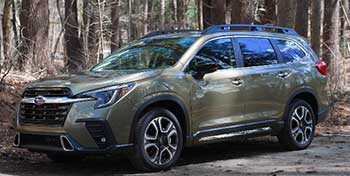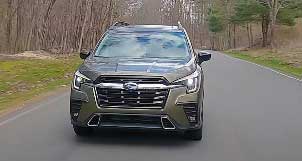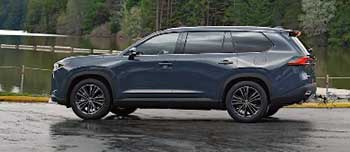
As a family-oriented driver who’s spent countless hours behind the wheel, I’ve always been on the lookout for the perfect three-row SUV that balances space, performance, and reliability.
The Subaru Ascent and Toyota Grand Highlander are two heavyweights in this category, each with unique strengths that make them appealing for different reasons.
My goal in this article is to share my firsthand experience comparing these vehicles, breaking down their pros, cons, and maintenance needs while helping you decide which one suits your lifestyle.
From road trips to daily commutes, I’ll explore what makes each SUV stand out.
Comparison Table
| Feature | Subaru Ascent | Toyota Grand Highlander |
|---|---|---|
| Starting MSRP | $41,415 | $42,355 |
| Fuel Economy (City/Hwy/Comb) | 20/26/22 mpg | 21/28/25 mpg |
| Engine | 2.4L Turbocharged Boxer 4-Cylinder | 2.4L Turbocharged 4-Cylinder |
| Horsepower | 260 hp | 265 hp |
| Torque | 277 lb-ft | 310 lb-ft |
| Drivetrain | Standard AWD | FWD (AWD Available) |
| Cargo Space (Behind 3rd Row) | 17.8 cu ft | 20.6 cu ft |
| Max Cargo Space | 75.6 cu ft | 97.5 cu ft |
| Seating Capacity | Up to 8 | Up to 8 |
| Infotainment Screen | 11.6-inch (Standard) | 8-inch (Standard), 12.3-inch (Available) |
| Safety Rating (NHTSA) | 5 Stars | 5 Stars |
| Maintenance Plan | Not Included | 2 Years/25,000 Miles Included |
My Experience With Subaru Ascent
I’ve driven the Subaru Ascent for a few weeks now, and it feels like a trusty companion built for adventure. Its rugged design and standard all-wheel drive (AWD) give it a go-anywhere vibe that’s hard to beat, especially if you live in a place with unpredictable weather.
The Ascent’s interior is practical, with a focus on functionality over flash, and its 11.6-inch touchscreen is a standout for tech-savvy families. On the road, the turbocharged boxer engine delivers a punchy 260 horsepower, making highway merges a breeze. It’s not the most luxurious SUV, but it’s a solid choice for those who value capability and safety.
The Ascent’s handling surprised me. Its low center of gravity, thanks to the boxer engine, makes it feel more agile than most three-row SUVs. I took it on a winding mountain road, and it held its own without feeling top-heavy. The cabin is spacious, especially for front and second-row passengers, though the third row is a bit tight for adults.
Cargo space is decent, but I found myself wishing for a bit more room behind the third row for weekend gear. Subaru’s EyeSight safety suite, standard across all trims, gave me peace of mind with features like adaptive cruise control and lane-keeping assist.
One thing that stood out was the Ascent’s off-road capability. I ventured onto a gravel trail during a family camping trip, and the SUV’s 8.7 inches of ground clearance and AWD system handled uneven terrain with ease. It’s not a Jeep, but it’s more than capable for light off-roading.
The ride quality is comfortable, though the continuously variable transmission (CVT) can feel a bit sluggish at times, especially when accelerating from a stop. Overall, the Ascent feels like a practical, no-nonsense SUV that’s ready for anything you throw at it.
Read more: My Thoughts on Acura Integra Vs. Honda Accord
Pros Of Subaru Ascent
- Standard All-Wheel Drive: Every Ascent comes with Subaru’s Symmetrical AWD, offering superior traction in rain, snow, or off-road conditions, unlike the Grand Highlander’s optional AWD.
- Safety First: The Ascent earns a five-star NHTSA safety rating and an IIHS Top Safety Pick+ award, with standard EyeSight features like automatic emergency braking and blind-spot detection.
- Spacious Cabin: With 42.2 inches of front-row legroom and ample second-row space, the Ascent is comfortable for families, though third-row legroom (31.7 inches) is slightly cramped.
- Punchy Performance: The 2.4L turbocharged boxer engine delivers 260 horsepower, making the Ascent quicker (0-60 mph in 6.9 seconds) than many competitors.
- User-Friendly Tech: The standard 11.6-inch touchscreen is intuitive, with Apple CarPlay and Android Auto integration, plus a unique Cabin Connect PA system for easy communication with rear passengers.
- Affordable Starting Price: At $41,415, the Ascent undercuts the Grand Highlander by nearly $1,000, offering great value for a fully loaded base model.
- Off-Road Capability: With 8.7 inches of ground clearance, the Ascent handles light off-road trails better than most midsize SUVs, perfect for outdoor enthusiasts.
The Ascent’s strengths lie in its versatility and value. I found the standard AWD to be a game-changer during a snowy drive, where the SUV felt planted and secure. The EyeSight system impressed me with its responsiveness, especially the adaptive cruise control, which smoothly adjusted to traffic.
The cabin’s layout is practical, with 19 cupholders (yes, I counted) and clever storage solutions. While the interior materials aren’t as upscale as some rivals, they’re durable and easy to clean, which is a win for families with kids or pets. The Ascent’s blend of performance, safety, and affordability makes it a compelling choice.
Cons Of Subaru Ascent

- Limited Cargo Space: With 17.8 cubic feet behind the third row and 75.6 cubic feet max, the Ascent lags behind the Grand Highlander’s generous cargo capacity.
- Tight Third Row: The third row’s 31.7 inches of legroom feels cramped for adults, making it better suited for kids on long trips.
- No Hybrid Option: Unlike the Grand Highlander, the Ascent lacks a hybrid powertrain, limiting its fuel efficiency to 22 mpg combined.
- Sluggish CVT: The continuously variable transmission can feel unresponsive, especially during quick acceleration, which detracts from the driving experience.
- Basic Interior Materials: While functional, the Ascent’s interior lacks the premium feel of the Grand Highlander, especially in higher trims.
- No Complimentary Maintenance: Subaru doesn’t offer a maintenance plan, unlike Toyota’s two-year/25,000-mile coverage, which adds to long-term costs.
- Smaller Dealer Network: With fewer Subaru dealers compared to Toyota, service and warranty work can be less convenient, especially in rural areas.
The Ascent’s cargo space was a letdown when I tried fitting a stroller and groceries behind the third row—there just wasn’t enough room. The third row was fine for my kids, but I wouldn’t ask an adult to sit there for more than a short drive.
The lack of a hybrid option stung when I saw my fuel bill after a long road trip, as the Ascent’s 22 mpg combined isn’t great for a family SUV. The CVT’s occasional lag annoyed me in stop-and-go traffic, and while the interior is practical, it doesn’t feel as polished as the Grand Highlander’s.
Maintenance Tips For Subaru Ascent
- Regular Oil Changes: Change the oil every 6,000 miles or six months using synthetic 0W-20 oil to keep the turbocharged boxer engine running smoothly.
- Tire Rotations: Rotate tires every 6,000 miles to ensure even wear, especially important with the standard AWD system that demands balanced traction.
- Check CVT Fluid: Inspect and replace the CVT fluid every 60,000 miles to prevent transmission issues, as the CVT can be sensitive to neglect.
- Brake Inspections: Check brake pads and rotors every 12,000 miles, as the Ascent’s weight can lead to faster wear, especially in hilly areas.
- Air Filter Replacement: Replace the engine and cabin air filters every 15,000 miles to maintain performance and air quality inside the cabin.
- Battery Maintenance: Test the battery annually, especially in cold climates, as the Ascent’s electronics rely heavily on a strong power source.
- Monitor AWD System: Have the AWD system inspected during routine services to ensure optimal performance, particularly if you frequently drive off-road.
Maintaining the Ascent is straightforward but requires diligence due to its turbocharged engine and AWD system. I learned the hard way that skipping oil changes can lead to sluggish performance, so I stick to the 6,000-mile schedule. Rotating tires regularly kept my Ascent handling crisply, especially on wet roads.
The CVT fluid check is critical—my mechanic caught a minor issue early, saving me from a costly repair. Brake wear was noticeable after a year of hilly driving, so I now budget for regular inspections. Keeping air filters fresh made a big difference in cabin comfort, especially for my allergy-prone kids.
My Experience With Toyota Grand Highlander
The Toyota Grand Highlander feels like a step up in refinement compared to the Ascent. Its sleek design and upscale interior make it feel more like a luxury SUV, especially in higher trims like the Platinum.
I drove it for a week, and the 2.4L turbocharged engine (265 hp) felt smooth and responsive, paired with an eight-speed automatic transmission that’s more engaging than the Ascent’s CVT. The Grand Highlander’s hybrid option, which I tested briefly, was a revelation, offering 36 mpg combined and making it a fuel-sipper for its size.
Cargo space is where the Grand Highlander shines. With 20.6 cubic feet behind the third row and a massive 97.5 cubic feet with seats folded, I easily fit a weekend’s worth of camping gear and a bike. The third row is more spacious than the Ascent’s, with 33.5 inches of legroom, making it viable for adults on shorter trips.
The interior feels premium, with soft-touch materials and an available 12.3-inch touchscreen that’s crisp and user-friendly. Toyota’s Safety Sense 2.5+ suite, standard across trims, rivals the Ascent’s EyeSight with features like lane departure alerts and pedestrian detection.
On the road, the Grand Highlander is quieter than the Ascent, with less road noise creeping into the cabin. I appreciated the included maintenance plan (two years/25,000 miles), which saved me on routine services like oil changes.
However, the base model’s front-wheel drive (FWD) felt less confident in wet conditions compared to the Ascent’s standard AWD. Adding AWD bumps the price, which starts at $42,355—slightly higher than the Ascent. Overall, the Grand Highlander feels polished and family-friendly, with a slight edge in comfort and efficiency.
Pros Of Toyota Grand Highlander

- Generous Cargo Space: With 20.6 cubic feet behind the third row and 97.5 cubic feet max, the Grand Highlander offers class-leading storage for family trips.
- Hybrid Powertrain Option: The hybrid model delivers 36 mpg combined, making it a fuel-efficient choice for budget-conscious drivers.
- Spacious Third Row: With 33.5 inches of legroom, the third row is more adult-friendly than the Ascent’s, ideal for extended family outings.
- Premium Interior: Higher trims feature soft-touch materials, ventilated seats, and a 12.3-inch touchscreen, giving the cabin a near-luxury feel.
- Smooth Transmission: The eight-speed automatic is responsive and engaging, outshining the Ascent’s occasionally laggy CVT.
- Included Maintenance Plan: Toyota’s two-year/25,000-mile maintenance plan covers oil changes, tire rotations, and more, reducing ownership costs.
- Strong Resale Value: The Grand Highlander retains 4.9% more value over five years compared to the Ascent, making it a better long-term investment.
The Grand Highlander’s cargo space was a lifesaver during a family road trip, easily swallowing luggage and sports equipment. The hybrid model impressed me with its fuel efficiency—I averaged 35 mpg on a 300-mile trip, saving me a chunk of change.
The third row accommodated my tall cousin comfortably for a two-hour drive, which the Ascent couldn’t match. The interior’s upscale vibe made every drive feel special, and the smooth transmission made city driving a breeze. Toyota’s maintenance plan was a nice perk, covering my first oil change and tire rotation for free.
Cons Of Toyota Grand Highlander
- Higher Starting Price: At $42,355, the Grand Highlander is pricier than the Ascent, especially when adding AWD, which isn’t standard.
- FWD Standard: The base model’s front-wheel drive is less versatile in adverse weather compared to the Ascent’s standard AWD.
- Smaller Dealer Network for Service: While Toyota has more dealers than Subaru, rural areas may still face service accessibility challenges.
- Less Agile Handling: The Grand Highlander’s higher center of gravity makes it feel less nimble than the Ascent on twisty roads.
- Slower Acceleration: Despite more horsepower (265 hp), the Grand Highlander takes 8.0 seconds to hit 60 mph, slower than the Ascent’s 6.9 seconds.
- Base Model Tech Lags: The standard 8-inch touchscreen feels dated compared to the Ascent’s 11.6-inch display, requiring an upgrade for the 12.3-inch screen.
- Limited Off-Road Capability: With 8 inches of ground clearance, the Grand Highlander isn’t as adept on rough terrain as the Ascent.
The Grand Highlander’s FWD base model struggled during a rainy drive, making me wish I’d opted for AWD. Its higher price tag gave me pause, especially since the Ascent offers similar features for less.
The base 8-inch touchscreen felt small and outdated, and I noticed the SUV’s handling wasn’t as sharp as the Ascent’s on curvy roads. Off-road, the Grand Highlander felt out of its element on a gravel path, lacking the Ascent’s ground clearance. Still, its overall refinement and cargo space kept it in the running for my family’s needs.
Also read: My Thoughts on Acura ILX Vs. Honda Accord
Maintenance Tips For Toyota Grand Highlander
- Oil Changes for Turbo Engine: Use synthetic 0W-20 oil and change every 7,500 miles or six months to keep the turbocharged engine in top shape.
- Tire Rotations: Rotate tires every 7,500 miles to ensure even wear, especially if you upgrade to AWD for better traction.
- Hybrid Battery Check: For hybrid models, have the battery inspected annually to maintain efficiency and avoid costly replacements.
- Brake Maintenance: Inspect brake pads every 15,000 miles, as the Grand Highlander’s weight can accelerate wear, particularly in urban driving.
- Coolant Flush: Replace coolant every 60,000 miles to prevent engine overheating, especially important for the turbo or hybrid powertrains.
- Cabin Air Filter: Swap the cabin air filter every 15,000 miles to ensure clean air and optimal HVAC performance for passengers.
- Transmission Fluid: Check and replace the eight-speed automatic transmission fluid every 60,000 miles to maintain smooth shifting.
Toyota’s included maintenance plan made my first year with the Grand Highlander hassle-free, covering oil changes and tire rotations. I stuck to the 7,500-mile oil change schedule to keep the turbo engine happy, and regular tire rotations improved handling on long drives.
The hybrid model’s battery check was quick and gave me confidence in its longevity. Brake inspections were crucial after noticing slight wear during city driving. Replacing the cabin air filter kept the interior fresh, especially during pollen season. A coolant flush at 60,000 miles ensured the engine stayed cool on summer road trips.
Comparison With Other Brands
- Honda Pilot: Offers a 3.5L V6 engine with 285 hp, outpacing both the Ascent and Grand Highlander in power, but lacks a hybrid option and has less cargo space (87 cu ft max) than the Grand Highlander.
- Kia Telluride: Boasts a premium interior and 291 hp V6, with 87.8 cu ft of max cargo space, but its fuel economy (20/26 mpg) trails the Grand Highlander’s hybrid.
- Hyundai Palisade: Similar to the Telluride with a 291 hp V6 and upscale cabin, it offers 86.4 cu ft of cargo space but lacks the Grand Highlander’s hybrid efficiency.
- Mazda CX-90: Features a 280 hp turbo inline-six and a sporty drive, with 74.2 cu ft max cargo, but its third row is tighter than both the Ascent and Grand Highlander.
- Volkswagen Atlas: Provides a massive 96.6 cu ft of cargo space and a 269 hp turbo engine, but its fuel economy (20/27 mpg) and interior quality lag behind the Grand Highlander.
- Jeep Grand Cherokee L: Offers off-road prowess and a luxurious interior, but its 84.6 cu ft max cargo and 20/26 mpg fuel economy fall short of the Grand Highlander.
- Chevrolet Traverse: Delivers 98.2 cu ft of max cargo space, beating both SUVs, but its 310 hp V6 and 18/27 mpg fuel economy don’t match the Grand Highlander’s hybrid efficiency.
The Honda Pilot felt more powerful than both SUVs, but its lack of a hybrid option and smaller cargo space made it less versatile. The Kia Telluride and Hyundai Palisade impressed with their upscale interiors, but their fuel economy couldn’t touch the Grand Highlander’s hybrid.
The Mazda CX-90 was fun to drive, but its third row was too cramped for my family. The Volkswagen Atlas offered huge cargo space but felt less refined. The Jeep Grand Cherokee L was great off-road but lacked the Grand Highlander’s efficiency. The Chevrolet Traverse had the most cargo room but felt less polished overall.
Frequently Asked Questions (FAQ)
The Subaru Ascent is slightly longer (196.8 inches vs. 194.9 inches) and taller (71.6 inches vs. 70.1 inches) than the Toyota Grand Highlander, but the Grand Highlander offers more cargo space (20.6 cu ft behind the third row vs. 17.8 cu ft).
The Toyota Grand Highlander edges out the Ascent for its hybrid option, larger cargo space, and included maintenance plan, but the Ascent is better for those prioritizing standard AWD and a lower starting price. Your choice depends on whether efficiency or all-weather capability matters more.
Toyota is actively selling the Grand Highlander as of 2025. It’s a newer model, launched in 2023, and is available at Toyota dealerships nationwide.
The Toyota Grand Highlander is the most direct competitor to the Subaru Ascent, offering similar three-row seating, safety features, and turbocharged performance, with the added benefit of a hybrid option.
Conclusion: For Subaru Ascent And Toyota Grand Highlander
After spending time with both the Subaru Ascent and Toyota Grand Highlander, I can say they’re both fantastic family SUVs, but your choice depends on your priorities. If you need standard AWD, a lower price, and solid off-road capability, the Ascent is your pick.
If you value fuel efficiency, a spacious third row, and a premium interior, the Grand Highlander is the way to go. I lean toward the Grand Highlander for its hybrid option and cargo space, but the Ascent’s rugged charm is hard to resist. Test drive both to see which fits your family’s adventures best.

